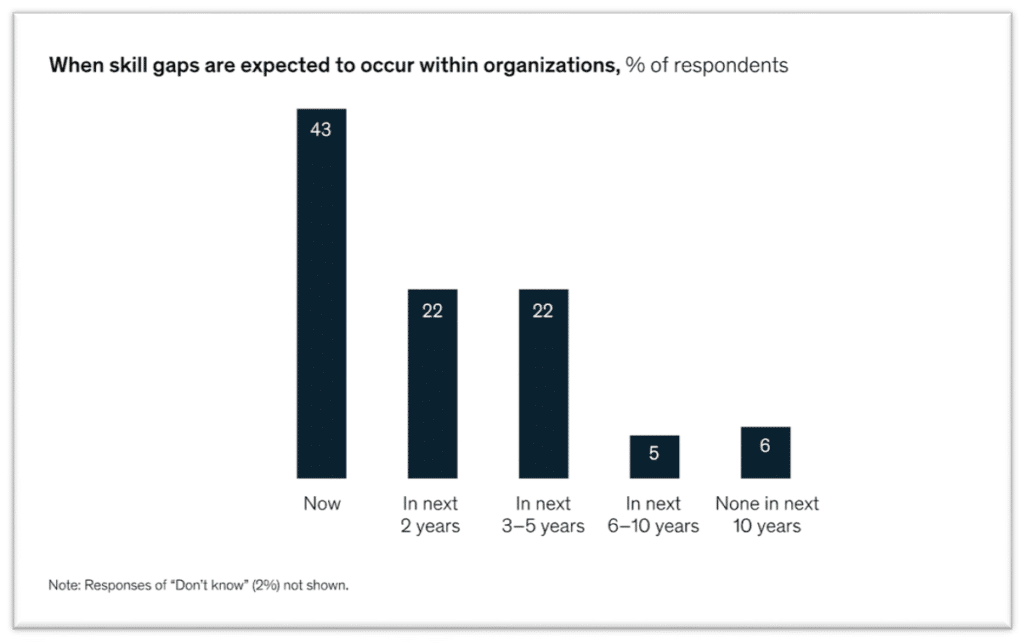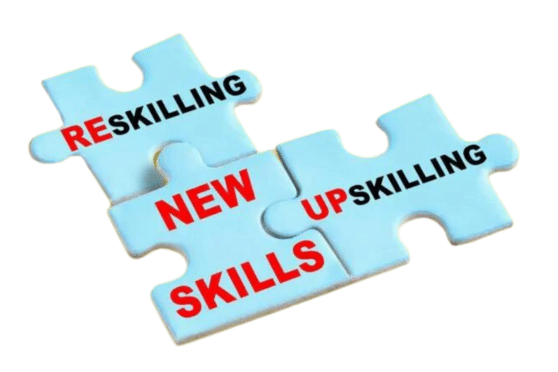In 2020, the World Economic Forum noted that “while 45% of business leaders communicate about automation initiatives, demonstrating their awareness of the situation, only 15% communicate about upskilling…and in the future, 9 out of 10 jobs will require digital skills.” Then in 2021, McKinsey & Company published the results of a survey in which 87% of respondents stated that their organization either already has a skills gap or expects to have a gap within a few years. With the rapid adoption of digital transformation and automation jumpstarted by more sophisticated AI technology, the change in skills needed at work has drastically changed even since 2021. The gap has only widened since. So what can companies due to remain relevant to their customer base?

https://www.mckinsey.com/featured-insights/sustainable-inclusive-growth/chart-of-the-day/mind-the-skills-gap
Solving the Skills Gap
Today’s rapidly changing work environment has made skill mobility a critical factor. Skill mobility refers to an organization’s capability of equipping employees to quickly adapt and learn new skills to meet the demands of evolving responsibilities in their current role and prepare them for taking on other roles soon. For individuals and organizations alike, skill mobility offers opportunities for career advancement, increased job satisfaction, and a better work-life balance. It allows individuals to stay relevant in a rapidly changing job market and opens up new personal growth and development opportunities. For organizations, skill mobility offers a competitive advantage in a rapidly changing business environment. It enables organizations to quickly adapt to new market demands and stay ahead of the competition. Building skill mobility cannot be achieved overnight. Talent activation is a lens the HR team can utilize to reimagine managing performance to orchestrate skills through upskilling and reskilling.
Talent Activation Meets Skill Mobility
Talent activation requires a deliberate effort on the part of both the individual and the organization to activate and develop skills continuously. This is where talent activation comes in. Talent activation involves identifying the skills critical for success in a particular role or function, developing a plan to activate those skills, and preparing the employee to gain additional skills to upskill/reskill to remain relevant to the organization and move into other key roles in the organization. By activating the talents of individuals, organizations can create a workforce that is adaptable and resilient to continuous change. This equips employees to move fluidly within the organization, increasing engagement and retention and reducing the expense of hiring and onboarding new talent. Skill activation can also lead to increased motivation. When individuals see the results of their efforts, they are more motivated to continue using their skills effectively. Skill activation can also enhance creativity. When individuals use their skills in new and innovative ways, they are more likely to develop creative solutions to problems. Skill activation can lead to work-life balance. When individuals can effectively use their skills, they can complete their work more efficiently. This can lead to more free time and a better work-life balance.
Activating Skills Mobility in the Employee Journey
Steve Bose noted in a recent article, “Before making investments that are so important to the future of their organization, it is important for HR leaders to map their requirements and goals for these ‘skills’ initiatives and assess the capabilities of their existing HRIS systems, as well as the newer solutions that have emerged throughout the pandemic.
Activation begins at the job posting stage. If a recruiter has been asked to backfill a role in which the prior incumbent had been for over a year, the likelihood of that job description needing an uplift is high. If utilizing a talent activation lens, then the recruiting team would pause and speak with the finance, department leader, and HR leader to ensure the requested headcount reflects the appropriate skills needed to drive future business initiatives. Job descriptions typically become obsolete within 6 to 9 months of hiring someone. Businesses need to iterate and continuously improve to remain relevant and drive customer renewal, which drives the evolution of the skills needed to succeed. Once job descriptions are aligned with the correct skills, interview guides should be tied to those skills, and the data gathered from the interviews should be kept to inform meaningful onboarding plan creation between the employee and hiring manager. Once the expectations for continuous growth are set, maximizing 1:1’s to provide real-time input into evolving expectations, the skills needed to succeed, and progress against them is key. Ensuring employees are equipped to have the right experiences to sharpen and grow skills becomes a manager’s ongoing work. HR and executives must maintain a regular cadence of strategic alignment and communication across the organization and grow leadership capability to foster collaborative teams that foster learning and skill growth.
5 Additional Ideas of How Talent Activation Creates Skills Mobility At Work
- Identify critical skills needed for success in a particular role or function. Conduct a skills gap analysis to determine the skills currently available and the skills that will be needed. Once the critical skills have been identified, a plan can be developed to activate those skills.
- Providing training and development opportunities can include on-the-job training, classroom training, and online learning. Providing various training and development opportunities is important to cater to different learning styles and preferences. Collaboration and teamwork can also help individuals activate their skills. By working with others, individuals can learn from their colleagues and apply their skills innovatively.
- Feedback and coaching are essential for skill activation. It is important to provide regular feedback to individuals to help them understand their strengths and areas for improvement. Coaching can also be provided to help individuals develop the skills they need to succeed in their roles. Finally, seeking feedback and mentorship can also help individuals activate their skills. By receiving constructive feedback and guidance from others, individuals can improve and apply their skills more effectively.
- Creating a culture of learning and development is essential for talent activation. This involves creating an environment where individuals are encouraged to learn and develop their skills continuously. This can include providing opportunities for job rotations, mentorship programs, job shadowing, interim assignments, and cross-functional projects.
- Digital augmentation reduces the time people spend searching for information and focusing on manual tasks to free them up to focus on skilling. Digital AI chatbots navigate employees to an organization’s resources and processes. An intelligent assistant helps employees in their day-to-day work by answering common questions and directing them to the appropriate tools. An AI guide can remind employees where to find their team’s quarterly goals tied to organizational objectives. An AI assistant can also provide tailored messaging to remind employees of the information they need at the moment it matters and serve as a coach to augment workplace training by using pulse surveys to reinforce learning and positive habit change. Chatbots can also point employees to career pathing guides and development resources.
Factors Affecting Skill Activation
While skill activation is important, several factors can affect an individual’s ability to activate their skills. Company culture can significantly impact an individual’s ability to grow their skills. A positive and supportive culture can encourage individuals to use their skills effectively. On the other hand, a fixed mindset, resistance to change, or toxic culture can discourage individuals from using their skills. To overcome this challenge, it is important to communicate the benefits of skill mobility and create a culture of learning and development. Personal motivation is also an important factor in skill activation. Individuals intrinsically motivated to activate their skills are likelier to do so. Motivation can come from various sources, including personal interests, career goals, and intrinsic rewards. Limited resources can also be a challenge for talent activation. To overcome this challenge, organizations can prioritize the critical skills needed for success and focus on providing training and development opportunities for those skills. A lack of support from leadership can hinder talent activation efforts. To overcome this challenge, getting buy-in from leadership and involving them in the talent activation process is important.
